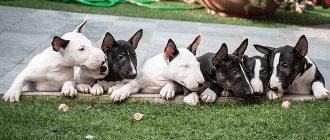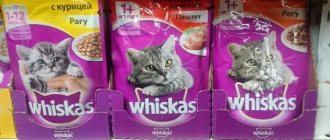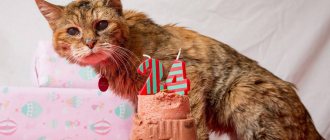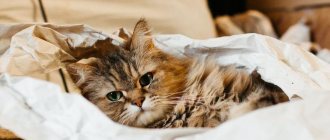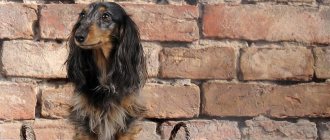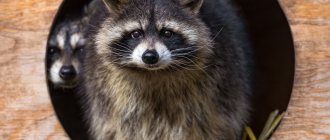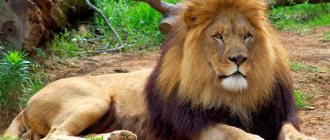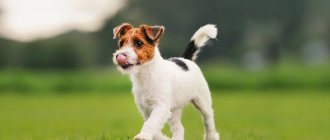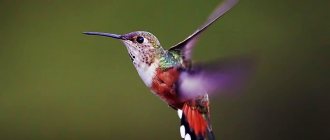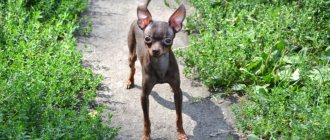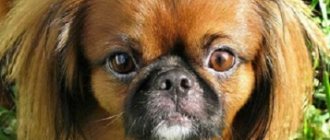The Coton de Tulear (Madagascar Bichon) is one of the breeds of dwarf dogs, the distinctive feature of which is white wool, comparable in its softness to cotton fiber. He will always follow his owner like a cotton ball, demonstrating his devotion and love.
Literally translated, the name of the breed means “Tulear cotton” and comes from the name of the city of Tulear, in Madagascar, where this breed developed.
Externally, the Coton de Tulear has similar features to the Maltese - it is a squat, small dog. The height of the Madagascar Bichon does not exceed 25-28 cm at the withers, and the average weight is from 2.5 to 6 kg. These funny dogs from Madagascar have a slightly elongated body, a wide chest, short and rather strong legs, and a triangular head. The back of the Coton de Tulear is straight and muscular, and the tail is thick, long and always in an elevated position.
The entire body of these dogs is covered with hair, the length of which reaches 8 cm. It is very soft, like cotton, thin and silky to the touch. In addition to the classic white color, there is also a black and white coat color for Coton de Tulear dogs.
Appearance and standard, photographs
The Thai Ridgeback is a dog with an athletic build and strong muscles.
A characteristic feature of the breed is the ridge, a strip of hair along the spine in the form of a ridge of wool growing in the opposite direction. The ridge has different shapes and lengths, but should be located symmetrically on both sides of the spinal column, without moving to the sides. Small curls are allowed at the front end of the comb. The breed is distinguished by elegance in its movements. The dog has a sweeping step and a powerful push. The running is easy, smooth, rhythmic.
The Thai Ridgeback must meet the following standards:
- Height at the withers for males is 61-66 cm, for females 56-61 cm. Weight, respectively, is 28-32 kg. and 25-30 kg.
- The head is flattened with a low forehead. The skin on the forehead folds like an accordion when the dog raises its eyebrows. Stop with a smooth transition.
- The muzzle is of medium length, tapering towards the end.
- Scissor bite. The upper jaw is blunt, the lower jaw is strong.
- The eyes are chocolate-colored and slightly squinting.
- The neck is strong, with powerful withers.
- The ears are large, set high, triangular.
- The chest is deep, with a pronounced sag.
- The back is straight, strong, with a wide loin. The croup is rounded.
- The stomach is taut.
- The tail is thick at the base, tapering towards the tip. Length to hock joints.
- The limbs are straight, muscular, with strong joints. Claws are even.
- The coat is short and smooth. There are varieties of wool: short velor - wool length 2 mm, velor - length from 3 mm. up to 1 cm, standard – 1-2 cm.
The disadvantages of the standard are:
- Uneven ridge.
- Lack of ridge.
- The coat is too long.
- Malocclusion.
Breed color options
The FCI standard establishes 4 solid colors of the Thai Ridgeback:
- Red is the most common. Let's say in variations from deep burgundy to light red. The main element of this color is red, which is weakly expressed or completely absent in the deer color. The red color is devoid of transitions in different parts of the body, in rare cases it is somewhat lighter on the hips and stomach.
- Black – has shades from blue-black to black-brown or black with a brown, olive tint. Black color is the most uniform throughout the body. When mated, this shade suppresses all others, so it is not very popular among breeders when breeding.
- Blue - shades from delicate smoky gray to rich dark gray. Blue Ridgebacks also have a grayish or bluish tint to their skin. The Thai Blue Ridgeback is the most popular breed all over the world. Blue Ridgebacks are often born with light or completely white chest patches. Breeders discard such specimens because the standard does not match this color.
- Fawn – This color is also called Isabella. Includes shades: pink, cream, cocoa, tea rose, boiled condensed milk. Isabella Ridgebacks are light at birth and darken after their first molt. The fur of an adult dog shimmers like a pearl.
Formation of appearance
The beauty of the Thai Ridgeback depends on its body meeting certain standards. In order for a dog to develop harmoniously and look appropriate, it needs physical activity, especially in the first year of life. The dog needs to be walked twice a day to ensure it gets enough exercise.
If the puppy has his toes splayed, he is led on gravel. Small pebbles get into the space between the toes, causing the dog to collect his toes in a heap. The entire muscle group can be strengthened by swimming. For a toned belly, it is recommended to let your dog carry a heavy load.
If the puppy's ears do not stand up as they should, you need to glue them with cotton swabs and adhesive tape.
To strengthen the ear in the desired position, it is glued using various devices. It is convenient to do this with a plastic cotton swab, which ideally fits the height of the ear. The ends of the cotton swab are cut off on both sides, on which the cotton wool is wound, and the tube is glued to the inner surface of the ear in a vertical position using an adhesive plaster. Then the ears are fastened crosswise using a strip of plaster. It turns out to be a kind of crown.
The structure is glued for 5 days, then a break is taken for several hours and after a massage it is fixed again. The ears are glued in this position until they are secured and stand on their own.
How to care for a handsome Madagascan cat
The Coton de Tulear dog does not require any specific care, but in order for the pet to always look neat and tidy, it is necessary to pay special attention to:
- Wool. It tends to get tangled and collect dust. To prevent this, you should brush your pet daily using a wide-toothed brush. In addition, the area around the eyes, nose and paws may become reddish-brown, so you will need to use special pet bleaching products sold in pet stores. The Coton de Tulear needs to be washed once every 2-3 weeks, as its long coat collects a lot of dirt and dust during walks. Before bathing, you should untangle all the tangles, otherwise if water gets on them, they will bunch up into a dense lump and then you will have to cut them out. After water treatments, the wool can be dried with a hairdryer. Coton de Tulear wool is hypoallergenic and practically does not shed.
- Nails - need to be trimmed as needed.
- Ears – your pet’s ears should be cleaned using a cotton swab moistened with water as they become dirty (approximately once a week).
- Paws - they are washed after every walk.
- Teeth. They need to be cleaned regularly (once a week). You can also pamper your pet with special teeth cleaning bones, which can be purchased at any pet store.
The Coton de Tulear can be clipped to make grooming easier. But dogs with a natural coat length are allowed to participate in exhibitions.
Walking with a pet
The Coton de Tulear is a very energetic dog, which means it requires regular active walks in the fresh air. 30-minute walks twice a day are a must for a pet’s comfortable stay in a city apartment. The dog will happily run after a stick or toy, trying to please its owner. It is necessary to walk with your pet in any weather. In severe frosts, you should wear special clothing, since the Coton de Tulear has no undercoat and can freeze.
The Coton de Tulear prefers active walks and will not refuse to run after a stick or toy.
What to feed your exotic pet
This exotic friend from Madagascar is absolutely unpretentious in food. The main condition is a balanced diet. He can eat both dry and wet industrial food, as well as natural food. If we are talking about purchased food, then it must be premium class or higher. Homemade food - freshly prepared.
It is necessary to exclude from the diet:
- fat meat;
- sweets and confectionery baked goods;
- bones, especially tubular bones;
- salty and spicy foods;
- sausages and smoked meats;
- potato;
- river fish.
Vegetables and fruits are welcome in the diet.
Characteristic
The Coton de Tulear belongs to the group of companion dogs, similar in type to the Bichon and Maltese. The standard does not require working tests for representatives of the breed.
FCI breed standard: No. 283
The Coton de Tulear is a small, cheerful dog with snow-white fur, an intelligent look and good manners. He gets along well with people - this is a characteristic feature of the breed.
The head of the cat is short and triangular in shape. The skull is wide, with an inconspicuous groove on the forehead, hidden brow ridges and pronounced dry cheekbones. The length of the head corresponds to the body in a ratio of 2:5, while the skull is much longer than the muzzle - 9:5.
The stop is expressed, but not significantly. The muzzle is straight and does not taper towards the nose. The lobe is black or brown, the nostrils are wide open. Thin lips fit well into jaws with a scissor, reverse scissor or level bite. The teeth are straight - an incomplete formula is allowed if P1 and M3 are missing. The pigmentation of the lips and eyelids matches the color of the earlobe.
Coton de Tulear breed
The Coton de Tulear's eyes are round, dark and have a lively, attentive expression. The ears are located at the top of the skull and hang down, close to the cheekbones. The tips of the ears are thin, covered with white hair interspersed with fawn, lemon or gray shades.
The curved neck of the Coton is well developed, there is no dewlap. The length of the neck is 1/5 of the total length of the body. The withers are weakly expressed, the strong line of the back is slightly arched upward. The loin is quite wide, with pronounced muscles, ending in a short sloping croup with a low-set tail, which the dog carries cheerfully and cheerfully, slightly bending the tip. In moments of joy, the Coton de Tulear raises its tail above its back.
The chest is quite wide and developed, descending to the level of the elbows - the ribs are arched. The belly line is selected and does not sag.
The front legs are set vertically and straight, the wrists continue the line of the forearms without a clearly defined transition. The hind limbs are developed, with dry hock joints. The paws are rounded, the toes are arched. Dewclaws are acceptable. The dog moves freely and evenly, without swaying.
There are many shortcomings and defects identified in representatives of the breed:
- flat or narrow skull;
- light or too bulging eyes, eyesore;
- almond-shaped eyes;
- narrow or horizontal croup;
- sagging or excessively arched back;
- short or thin neck;
- twisted or tucked limbs;
- short or wavy coat;
- partial pigmentation of the lips, nose and eyelids;
- insufficient expression of breed characteristics;
- deviations of height and weight from the standard;
- erect ears;
- short or curled tail;
- spotted color;
- convex nasal bridge;
- snack with waste, undershot;
- absence of teeth, with the exception of M3/P1
Dimensions, weight and height of the breed
The optimal height for males according to the standard is 26-28 cm. Females are slightly lower - 23-25 cm. Deviations are allowed for both sexes: 1 cm on the smaller side and 2 cm on the larger side. The weight is also stated in the document: for a male 4-6 kg, for a female 3.5-5 kg.
Coton de Tulear - description of the breed
Possible colors
The Coton de Tulear has pink, elastic skin that fits well all over the body, without folding. Slight pigmentation is acceptable. The dog's fur is unique, reminiscent of cotton threads in texture - very soft and pliable.
Color – white with a possible admixture of light gray or fawn on the ears and other parts of the body
It is important that inclusions of hairs of a different color do not disturb the overall impression of whiteness.
Puppy weight by month
Small Coton puppies are born weighing from 300 to 700 g. Development occurs quickly. Age to weight ratio:
- 1 month – 0.8 kg;
- 4 months – 1.3 kg;
- 6 months – 2 kg;
- 9 months – 3-5 kg.
In order for the Coton de Tulear puppy to gain weight evenly, it must be fed in accordance with the regime and diet, periodically feeling its sides and assessing its fatness.
Coton de Tulear puppies
Lifespan
Small dogs live longer than large ones - the life expectancy of a Coton is 13-16 years with minimal care and average physical activity.
Allergenicity
Allergies in humans can manifest themselves to dog fur, salivation, and even dog excrement. If you suffer from allergic reactions to dead dog hair, the Coton de Tulear may be a good choice for a four-legged friend. It practically does not shed, and does not leave behind a “dog” smell.
To check for allergies, get tested, and additionally visit the breeder and spend the whole day talking to its puppies, having previously stocked up on antihistamines.
History of the breed
The breed was first talked about when, in the 17th century, French sailors brought small dogs with features reminiscent of the Bolognese and Bichon Frize to Madagascar. A distinctive feature of the dogs was their unusual snow-white fur, comparable in feel to cotton. The resemblance to the softest plant fiber gave the breed its first name (coton is translated from French as cotton), and Tulear is a Madagascar port. The dogs received their second name in honor of the island they arrived on together with the sailors, and the related group of bichons (lapdogs).
For a long time, the breed remained unknown to the general public. It became widespread only in the 20th century, when its representatives began to be imported into the USA and Europe. Dog lovers appreciate the beauty and good-natured disposition of these small but strong dogs. The breed is gradually winning the hearts of Russians, but still remains quite rare.
The Coton de Tulear is still not officially recognized as a breed, so it has no standards.
Characteristic
The Coton de Tulear belongs to the group of companion dogs, similar in type to the Bichon and Maltese. The standard does not require working tests for representatives of the breed.
FCI breed standard: No. 283
The Coton de Tulear is a small, cheerful dog with snow-white fur, an intelligent look and good manners. He gets along well with people - this is a characteristic feature of the breed.
The head of the cat is short and triangular in shape. The skull is wide, with an inconspicuous groove on the forehead, hidden brow ridges and pronounced dry cheekbones. The length of the head corresponds to the body in a ratio of 2:5, while the skull is much longer than the muzzle - 9:5.
The stop is expressed, but not significantly. The muzzle is straight and does not taper towards the nose. The lobe is black or brown, the nostrils are wide open. Thin lips fit well into jaws with a scissor, reverse scissor or level bite. The teeth are straight - an incomplete formula is allowed if P1 and M3 are missing. The pigmentation of the lips and eyelids matches the color of the earlobe.
Coton de Tulear breed
The Coton de Tulear's eyes are round, dark and have a lively, attentive expression. The ears are located at the top of the skull and hang down, close to the cheekbones. The tips of the ears are thin, covered with white hair interspersed with fawn, lemon or gray shades.
The curved neck of the Coton is well developed, there is no dewlap. The length of the neck is 1/5 of the total length of the body. The withers are weakly expressed, the strong line of the back is slightly arched upward. The loin is quite wide, with pronounced muscles, ending in a short sloping croup with a low-set tail, which the dog carries cheerfully and cheerfully, slightly bending the tip. In moments of joy, the Coton de Tulear raises its tail above its back.
The chest is quite wide and developed, descending to the level of the elbows - the ribs are arched. The belly line is selected and does not sag.
The front legs are set vertically and straight, the wrists continue the line of the forearms without a clearly defined transition. The hind limbs are developed, with dry hock joints. The paws are rounded, the toes are arched. Dewclaws are acceptable. The dog moves freely and evenly, without swaying.
There are many shortcomings and defects identified in representatives of the breed:
- flat or narrow skull;
- light or too bulging eyes, eyesore;
- almond-shaped eyes;
- narrow or horizontal croup;
- sagging or excessively arched back;
- short or thin neck;
- twisted or tucked limbs;
- short or wavy coat;
- partial pigmentation of the lips, nose and eyelids;
- insufficient expression of breed characteristics;
- deviations of height and weight from the standard;
- erect ears;
- short or curled tail;
- spotted color;
- convex nasal bridge;
- snack with waste, undershot;
- absence of teeth, with the exception of M3/P1
Dimensions, weight and height of the breed
The optimal height for males according to the standard is 26-28 cm. Females are slightly lower - 23-25 cm. Deviations are allowed for both sexes: 1 cm on the smaller side and 2 cm on the larger side. The weight is also stated in the document: for a male 4-6 kg, for a female 3.5-5 kg.
Coton de Tulear - description of the breed
Possible colors
The Coton de Tulear has pink, elastic skin that fits well all over the body, without folding. Slight pigmentation is acceptable. The dog's fur is unique, reminiscent of cotton threads in texture - very soft and pliable.
Color – white with a possible admixture of light gray or fawn on the ears and other parts of the body
It is important that inclusions of hairs of a different color do not disturb the overall impression of whiteness.
Puppy weight by month
Small Coton puppies are born weighing from 300 to 700 g. Development occurs quickly. Age to weight ratio:
- 1 month – 0.8 kg;
- 4 months – 1.3 kg;
- 6 months – 2 kg;
- 9 months – 3-5 kg.
In order for the Coton de Tulear puppy to gain weight evenly, it must be fed in accordance with the regime and diet, periodically feeling its sides and assessing its fatness.
Coton de Tulear puppies
Lifespan
Small dogs live longer than large ones - the life expectancy of a Coton is 13-16 years with minimal care and average physical activity.
Allergenicity
Allergies in humans can manifest themselves to dog fur, salivation, and even dog excrement. If you suffer from allergic reactions to dead dog hair, the Coton de Tulear may be a good choice for a four-legged friend. It practically does not shed, and does not leave behind a “dog” smell.
To check for allergies, get tested, and additionally visit the breeder and spend the whole day talking to its puppies, having previously stocked up on antihistamines.
Price and selection of puppies
Those wishing to get a Coton de Tulear puppy should remember that the breed is not very common in Russia. Dogs may not be available for free sale. Those who are aiming to adopt a pet of this particular breed are recommended to reserve their babies even before mating. There is a possibility that puppies will be quickly snapped up due to the small number of reputable breeders.
Read Cane Corso - the pros and cons of a purebred Italian
Another option is to buy a Coton from a responsible fancier who breeds his own dog. It is necessary to make sure that the seller has selected a pair through the club and registered the litter. Before purchasing, you should personally inspect the living conditions of the dogs. The puppy must have a brand, a puppy card and vaccination records.
It is advisable to take your baby to a new home no earlier than 2.5 months. In babies, dark marks on the face and body are acceptable; this is not a sign of mixing with another breed. By the age of two, the spots will disappear and the dog will become completely white. Puppies are ready to go to a new home at the age of 2.5 months. On average in Russia, the price for a Madagascar Bichon from a receiver is 50,000 rubles; fanciers ask for less - from 30,000 thousand. The cost is influenced by the pedigree of the parents, the status of the breeder, and the prospects of the puppies. Girls are slightly more expensive than boys. In the West, prices are much higher. In America, the lower limit is $2,000, show-class dogs cost from $3,000.
Diseases and health problems
Bichons are generally healthy, but like all breeds, they are susceptible to certain diseases.
Not all Bichons carry any or all of these diseases, but it is important to be aware of the possibility.
Health problems that Bichon Frize may face:
- Bladder problems. Bladder stones and infections are not uncommon in this breed. Many factors can cause bladder stones, including excess protein, magnesium and phosphorus in the diet or long periods of time between urinating. Bladder infections can be caused by bacterial or viral infections. If your Bichon needs to urinate frequently, has bloody urine, or has difficulty urinating and loss of appetite, you should take him to the veterinarian for an examination;
- Allergy. Can affect Bichons due to several different causes, including contact allergies and food allergies. Bichons are also known to be susceptible to fleas. If your Bichon scratches, licks its paws, or frequently rubs its face, you should suspect an allergy;
- Knee dislocation. Also known as pinched knees, this is a common problem in small dogs. An anatomical (bone in a joint) or patellar luxation can occur when the knee joint (often on the back leg) slips inward, causing pain. This can be harmful, although many dogs lead relatively normal lives with this problem;
- Sensitivity to vaccination. Affects some Bichons and many suffer even with routine vaccinations. Symptoms usually include hives, swelling, tenderness and lethargy. In rare cases, a vaccine-sensitive dog may develop complications or even die;
- Hip dysplasia. This is an inherited condition in which the femur bone does not fit tightly into the hip joint. Some dogs experience pain in one or both back legs, but others show no outward signs of discomfort. X-ray screening is the most accurate way to diagnose the problem. Either way, arthritis can develop as a dog ages;
- Cataract. Sometimes develops in relatively young (less than six years old) Bichons. This is considered a hereditary disease.
Purpose and character of Coton de Tulear
Cotons were kept exclusively as companions for many centuries. These small dogs are very friendly and affectionate to the owner as well as his family. They get along well with children. Moreover, they do not require such careful treatment as other breeds of small dogs.
The Coton guard dog is, to put it mildly, bad. This friendly little guy would rather show a stranger into the house, considering him a potential friend, than drive him away. Nevertheless, the Coton always regularly notifies about the appearance of unexpected guests.
In France, Cotons are often called “clowns.” Not without reason. These small dogs love to amuse their owners so much that they tend to behave playfully and humorously almost all the time. Many cats love to please their owners with tricks and nonsense. Their character is often compared to Labrador retrievers.
Cotons are very attached to their family. They strive to always be in the company of close people and experience long separation very painfully - they begin to bark loudly and spoil all the things that come their way.
This breed is much better suited to families with children than other similar breeds. Cotons get along well with children, and some even prefer their company, trailing them all day long.
The friendliness of fur babies extends not only to the owner's family members, but also to strangers. Often the dog has to be weaned from greeting all guests by jumping on the face and licking. However, there are also some Cotons that form very strong bonds with their owners and are conservative towards strangers.
The Coton gets along quite easily with other dogs and pets. He is not characterized by aggression.
Key points in training
Despite the fact that Cotons are decorative, they need to be trained and educated from childhood. Puppies are taught the rules of behavior in the house. This breed trains well, accepts all instructions from its owners, and listens to members of the household. Therefore, problems with education do not arise if it is structured competently and in a timely manner. From the age of 2 months, the pet is told what is possible and what is not; They are forbidden to sleep in bed with the owner and chew human things.
It is prohibited to use harsh methods of punishment or brute force. To show a dog that it is wrong, all it takes is a stern tone, a look, or deprivation of a treat or toy. The best teaching method remains motivational - stimulation with goodies.
These dogs are often called circus dogs or clowns; they really do all the tricks easily. Not all Cotons are taught to carry out any special commands, but any dog needs to know the basic signals: “sit”, “lie down”, “place”, “no”, “voice”, “near”. By 3-4 months, the puppy should know its name .
Read about how to properly train a dog in the article: “Training a puppy: effective methods from dog handlers, learning commands at home.”
You can resort to the help of a kennel club or conduct group training with other dogs. This way the pet can learn from the example of others and socialize.
Features Overview
Actually, there is a little secret that sets this horse apart from all the others. So, the Soviet heavy truck is simply ready to discover its own unsurpassed strength. As a workhorse, the Soviet heavy truck cannot have a single rival.
Large constitution and tall stature
But on various kumys farms, fillies are of bright and ardent interest. As for meat production, there are also no equals to this glorious breed. Indeed, in meat production, there are simply no equals in terms of great precocity.
And now the “Soviet draft horse” is already in a hurry to receive well-deserved recognition back in 1952. So the breed can be called relatively young. As for the popularity of the new horses, they met all of their most basic qualities. Then there were long-term improvements of the breed and many other interesting processes. Now we can say that progress has created animals that are superior in all respects to many of their own kind.
The Soviet heavy truck is the largest of all existing ones. At the same time, the head is, surprisingly, of medium size, and the neck is muscular and of medium length. As for the withers, they are low and wide. At times it is soft. The back is level and the lower back is wide. The croup is drooping and forked. Wide chest.
Photo of a red Soviet heavy truck
Advantages and disadvantages
Like any other breed, the Madagascar Bichon has its advantages and disadvantages.
The main advantages noted by dog handlers are as follows:
- kindness and friendly attitude towards people and animals;
- good immunity, better health than most small breeds;
- perfectly trainable, easy to train;
- are active and energetic, love outdoor games, but do not require long walks;
- moderate shedding;
- no unpleasant odors.
There are also some disadvantages that should be taken into account before purchasing. As a rule, this is the difficulty of caring for the spectacular coat of a Coton.
Among the shortcomings are the following:
- snow-white dogs get dirty and dusty very easily;
- since the wool is of an elongated type, it turns into tangles and becomes tangled;
- everything instantly sticks to the wool;
- constant and fairly careful care is required for the pet to look beautiful, if this is not provided, an unkempt appearance is guaranteed;
- unkempt fur leads to a number of serious infectious diseases;
- the bark of the Cotons is too shrill;
- If a dog is not trained, it is completely uncontrollable; untimely socialization will lead to aggressiveness.
Mating
Breeding such large dogs can be a challenging process.
- Firstly, you will need a lot of space.
- Secondly, to help animals you will have to make physical efforts.
- Thirdly, only a specialist or an experienced dog breeder can set pets in the right mood.
Large dogs mature at the age of 24-30 months, although estrus in girls begins already at 8-12 months. But at this age they are not physically ready to bear and give birth to healthy offspring. Starting from the third heat, pets can be bred. The stage of cell maturation occurs on days 13-15 from the start of estrus. At this time, the loop softens and the discharge becomes transparent.
A few days before estrus, the owner of the female contacts an official nursery or club to find a suitable partner. After this, the owners of the bitch and the dog agree on the date and place of the mating and fill out the necessary documents. This will allow future puppies to be registered in the breed book and documents issued to them. The price is set by the owner of the male; it is equal to one puppy or a percentage of its cost, depending on the number of babies born.
Two weeks before mating, animals are cleaned of worms and ectoparasites. In addition, you need to check both the male and the female at the veterinarian for the presence of piroplasmosis or other dangerous diseases that can harm the puppies.
On the appointed day, the dogs are brought together on the territory of the dog or in a neutral place (kennel club, park). Animals need to be given time to get to know each other. The dogs sniff each other and get used to it. An experienced female herself knows when to let a male in. If she does not allow the cage to be done, it is worth postponing the mating to the next day. During the act, the owners need to support the female under the belly, and guide the male into the noose.
Lifestyle in nature
In order to find an approach to a horse of this breed, you need to create comfortable living conditions for it and know what kind of care the animal needs.
Maintenance and care
The Soviet draft horse has no special preferences; it needs a spacious stable, a place for walking and free running, clean drinking and regular food. In order for a horse to work for the benefit of humans, the owner must take care of the health of the animal. Firstly, a properly formulated diet and feeding will help the horse maintain its energy and strength. Secondly, regular examination of the horse after a day of work will prevent the risk of diseases and injuries. And several times a year, the draft horse must be examined by a veterinarian, as well as undergo all routine vaccinations and vaccinations.
After an active pastime, the horse needs to clean the nostrils of sweat and dust, and also wash the hooves with a hose to relieve fatigue. The mane and tail should be washed 1-2 times a week using conditioner and combed with a natural brush. To prevent your hair from getting tangled, you can braid it.
Nutrition
A properly formulated diet for the Soviet heavy truck is the key to its strength and power, productivity and energy. Heavy trucks equally need feeding with fresh and dry vegetation, as well as cereal crops. Therefore, every day the horse needs to be given grass and grain, as well as clean water. In order for a young foal to fully grow and build muscle, it is necessary to periodically feed the animal with concentrates and vitamin supplements. Horses love sugar, sweet beets and carrots, as well as potatoes.
Character and habits
The Soviet heavy truck is famous for its certain phlegmatic nature and excellent disposition. And the energetic temperament allows the horse to work most productively in tandem with a person. In general, the temperament of Soviet heavy trucks is balanced, good-natured, unpretentious and calm. Horses easily make contact with new people, but require a respectful and gentle approach. Negative emotions and anger are not welcome in people; only the “carrot method” can induce diligence and diligence in a horse.
Care and maintenance
The Coton de Tulear is suitable for keeping at home. The small size of the animal makes it easy to allocate a place for it in the house, which will not bring difficulties to its residents. Despite the presence of a fluffy white fur coat, the pet sheds very imperceptibly; fallen hairs do not cause problems with cleaning the home, as they remain in the dog’s fur.
A distinctive feature of this breed is the absence of a pungent odor inherent in most domestic dogs, which becomes another advantage in keeping it.
To maintain a positive attitude in your pet, you need to set aside at least half an hour every day to play with him, as cats love active games. A lack of active life can lead to negative consequences and a deterioration in the dog’s well-being.
Puppies of this breed require soft food or fluids rich in protein and calcium to develop a strong and strong body. You should feed 4 times a day, but do not leave the plate at the feeding site. It is better to pick her up after 20 minutes, which will teach the puppy to the correct regime.
It is recommended to switch to solid food in the second month after birth, and to food for adult dogs at 8-9 months, while reducing the number of meals to 2 times a day. The pet's menu should include vegetables, fruits, meat, fish, so that the sensitive body can receive the necessary vitamins and nutrients from natural products.
How to choose a puppy
It is recommended to take home a puppy older than one and a half months. When purchasing, check the necessary documents about the origin of the puppy, vaccination card, and health examination of its parents.
Make sure the puppy meets the breed standard:
- The head is triangular in shape, short, with a convex skull. The nose is dark.
- The round-shaped eyes are deep-set and widely spaced. They have a dark color.
- Thin, wide-set ears are of medium length, hanging, close to the cheeks. The tips can be painted a different color.
- The shape of the body is stretched, squat. The neck has no dewlap, the chest is wide, with pronounced ribs, the back is straight, the croup is wide.
- The developed paws have strong muscles and are short. The toes are gathered together.
- The tail is set low, curls into a ring on the back when moving, and hangs down when at rest. The length of the tail can reach 17 cm.
